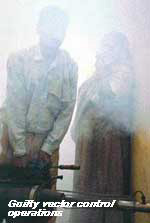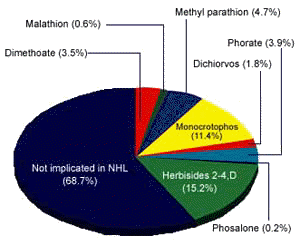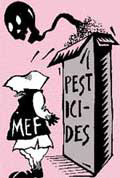 Since the use of
pesticides, particularly phenoxy herbicides (2,4-d, 2,4,5-t or
2,4,5-trichlorophenoxyacetic acid, and mcpa or 2-methyl-4-chlorophenoxyacetic acid) and
organophosphate pesticides has increased over the last 40 years, the nci argues that they
could have played a significant role in contributing to the rising incidence of nhl. Since the use of
pesticides, particularly phenoxy herbicides (2,4-d, 2,4,5-t or
2,4,5-trichlorophenoxyacetic acid, and mcpa or 2-methyl-4-chlorophenoxyacetic acid) and
organophosphate pesticides has increased over the last 40 years, the nci argues that they
could have played a significant role in contributing to the rising incidence of nhl.
According to a book written by itrc’s N K
Mehrotra, there are several pesticides which cause cancer of the lymphatic system in
experimental animals (rats and mice).
The general population can be exposed to pesticides in three ways:
 through
vector control through
vector control
 through
residues in environment through
residues in environment
 through
residues in food through
residues in food
Pest controllers
Pesticides which cause lymphatic cancer in rats and mice |
| 1. Toxaphene (organochlorine,
general name Camphechlor) |
| 2. Hexachlorocyclohexane
(organochlorine, used as gamaxine) |
| 3. Trichlorophenol |
| 4. Strobane (organochlorine) |
| 5. Perthane |
| 6. TCDD (Dioxin) (a
chlorophenoxy herbicide, which is often found as a contaminant in trichlorophenol,
hexachlorophene and 2,4,5-T ) |
| 7. Dieldrin (organochlorine) |
| 8. DDT (organichlorine) |
| 9. 1, 2 Dichloroethane (DDE,
breakdown product of DDT) |
| 10. Heptachlor |
| 11. Picloram |
This segment of population tends to have only a
low-dose, chronic exposure, but larger doses can be transmitted if the exposure is
persistent and bioaccumulative. Persistent pesticides move through air, soil and water,
finding their way into living tissues where they can bioaccumulate up the food chain into
human diets. Roughly 85-90 per cent of pesticides applied agriculturally never reach
target organisms, but disperse through the air, soil and water. People who can be exposed
to high levels of bioaccumulated pesticides include
 habitual
consumers of fish, livestock and dairy products; habitual
consumers of fish, livestock and dairy products;
 foetuses
and nursing infants whose mothers bodies have accumulated persistent pesticides; and, foetuses
and nursing infants whose mothers bodies have accumulated persistent pesticides; and,
 sick
people who metabolise their fatty tissues (which contain bioaccumulated pesticides) while
ill. sick
people who metabolise their fatty tissues (which contain bioaccumulated pesticides) while
ill.
People in Delhi have
one of the highest levels of DDT in their body fat
According to an itrc survey of studies on
pesticide residues, high levels of residues of bhc, lindane, heptachlor, endosulphan and
dieldrin have been found in just about everything necessary for life from food to water.
List of suspects
NHL implicated pesticides and their consumption in Indian
agriculture (’93-94) |
 |
Nearly 40 per cent of pesticides consumed
by our farms are
possible causative agents of Non-Hodgkin’s Lymphoma |
The list does not even include tea whose
ddt residues are so high that Germany is refusing to import Indian tea.
How do these residue levels compare with
residues in industrialised countries or with acceptable daily intake (adi) standards?
Badly, at best. A report published in 1992 in the Journal of Agriculture and Food
Chemistry by K Kannan and A Subramaniam concludes: “Significantly high levels of food
contamination with hch, ddt, aldrin and dieldrin were evident throughout India...The
average daily intake of hch and ddt...were higher than those observed in most of the
developed nations. The dietary intakes of aldrin and dieldrin exceeded the acceptable
daily intake recommended by who/fao....” Studies have shown that people in Delhi have
one of the highest levels of ddt bioaccumulated in their body fat. Another study of 1991
on pesticide residues in Delhi by A Nair and M K K Pillai reports that ddt and hch
residues were present in Delhi’s water, soil and fauna. Human breast milk samples in
Delhi show ddt and hch levels comparable to those found in Punjab, an area of intensive
farming. Infants ingesting this breast milk receive roughly 12 times the allowable daily
intake of ddt.
Home truth
Environmental pollution does not spare even those concerned about the environment |
Official statistics show that every seventh to
10th person living in Delhi, Mumbai, Madras and Bangalore is likely to fall prey to cancer
during his lifetime. I was keen to check whether this rate applied to people I know
personally — among the board members of the Centre for Science and Environment (CSE).
I found that the lifetime cancer incidence rate in this group was,
sadly, on the higher end of the officially predicted range. What is worse is that as many
of the board members are still young, the full story has not yet been told. Since 1980,
CSE has had a total of 45 board members. Of these, 34 have lived for long in the four
accursed metropolises listed above. Of them, five have already been stricken with cancer
— one from brain cancer, one from breast cancer, one from prostate cancer and two
from Non-Hodgkin’s Lymphoma — leading to a lifetime incidence rate of slightly
more than one in seven. |
Adding to the concern about carcinogenic effects
of pesticides are the latest findings of a new discipline of science called
immunotoxicity, which studies substances with a negative impact on the immune system. A
recent review of over 100 primary experimental studies of immunosuppressive nature of
pesticides reports that the large majority of these studies reveal various types of
immunosuppressive effects. Reduced immunity influences cancer incidence. A weak or
devastated immune system allows cancerous cells to escape and form a tumour. One can only
imagine the kind of havoc pesticides can play in a country where a large percentage of the
population is malnourished and, hence, suffers from immunodeficiency.
The maximum likelihood
of exposure in my case is through food and water
Organic solvents and other industrial chemicals
According to nci, exposure to organic solvents also leads to increased risk of nhl.
According to Shiela Zahm, “There is now a strong feeling amongst scientists that
apart from pesticides, organic solvents play an important role.” Organic solvents are
widely used in the paints industry, in dry-cleaning and woodcrafts, and large numbers of
workers are potentially exposed to them. Among the solvents which are suspected
carcinogens are chlorinated hydrocarbon solvents, methylene chloride, trichloroethylene,
chloroform, formaldehyde and benzene. A Swedish study also lists styrene,
trichloroethylene, perchloroethylene and chlorophenols as substances whose exposure
heightens the risk of nhl. A British study shows heightened risk of nhl amongst those
exposed to wood dust and expoxy glues.
Tenuous links
On NHL’s associations with ailments like asthma |
 According to National Cancer Institute (US)
scientists, “Weak associations (with Non-Hodgkin’s Lymphoma or NHL) have been
noted for some common (medical) conditions... like asthma, allergies, rheumatoid
arthritis, rheumatic fever, tuberculosis and infectious mononucleosis, and commonly taken
steroidal drugs. Some conditions that warrant further investigation include asthma and
steroid use.” According to National Cancer Institute (US)
scientists, “Weak associations (with Non-Hodgkin’s Lymphoma or NHL) have been
noted for some common (medical) conditions... like asthma, allergies, rheumatoid
arthritis, rheumatic fever, tuberculosis and infectious mononucleosis, and commonly taken
steroidal drugs. Some conditions that warrant further investigation include asthma and
steroid use.”
Steroids are known to be immunosuppressive; asthma too is an immune
system disorder. Asthma — known to get exacerbated by air pollution — cases have
been rising in many countries lately. In the US, 10 million people — four per cent of
the total population — suffer from asthma. I have been an asthmatic for more than 30
years now and Delhi’s growing air pollution has definitely not helped much. Still,
these are weak associations suggested by epidemiological studies, and US scientists
continue to look for other major causes of increase in NHL. |
Says Zahm, “The general population is also exposed to
these carcinogens through commercial products and contamination of drinking water
sources.” Enquiries in India conducted by researchers of cse reveal that no study of
contamination of drinking water sources by these solvents has been conducted so far.
Studies, however, have shown that the following solvents were present in effluents of the
paint industry:
2,4,6-Trichlorophenol Benzene
2,4-Dichlorophenol Chloroform
2,4-Dinitrophenol Methylene
4,6-Dinitro-o-cresol Chloride
Pentachlorophenol Trichloroethylene
Phenol
What is frightening is that not all these contaminants can be removed by existing
wastewater treatment processes in India, thus leading to the contamination of natural
water sources which ultimately provide us with drinking water.
Eco-mandarins: a
no-show
The MEF is non-functional as far as controlling hazardous pesticides is concerned |
 What does the baby of environmental concern
— the much-hyped Union ministry of environment and forests (MEF) — do to protect
human beings from harmful pesticides? Precious little, it seems. What does the baby of environmental concern
— the much-hyped Union ministry of environment and forests (MEF) — do to protect
human beings from harmful pesticides? Precious little, it seems.
The ministry has neither restricted the use of hazardous pesticides and monitored
pesticide-induced pollution nor studied the health or overall environmental impact of
pesticides. The agriculture ministry is responsible for approving pesticides. The MEF,
says a senior official, acts only if an accident were to occur in a pesticide firm, a la
Union Carbide in Bhopal.
Says R R Khan, the scientist in charge of MEF’s technical unit dealing with safety
aspects of pesticide use, “We only have an advisory role. We offer advise to the
ministry of agriculture regarding safe use of pesticides. We also conduct regular training
programmes for pesticides industries as well as users.” Period. This is the state of
environmental governance in India. If the ministry closed down tomorrow, it would make no
difference to mine or your health. Then why should we pay taxes to this incompetent
government? |
|


